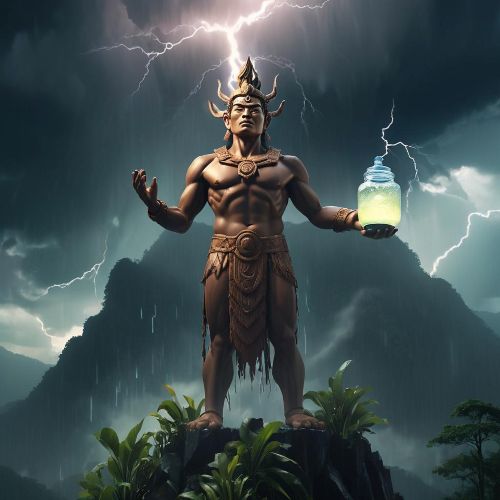Gaki : The Hungry Ghost
Listen
At a glance
| Description | |
|---|---|
| Origin | Japanese Mythology |
| Classification | Ghosts |
| Family Members | N/A |
| Region | Japan |
| Associated With | Hunger, Evil |
Gaki
Introduction
Gaki, or hungry ghosts, are a compelling aspect of Japanese mythology, blending religious, cultural, and moral themes. These entities are believed to be the spirits of individuals who, due to their greed, deceit, or selfishness in life, are condemned to a state of eternal hunger and thirst in the afterlife. Residing in the Gakido, their grotesque appearance and endless suffering highlight the consequences of negative karma and underscore the importance of compassion and generosity. The tales of Gaki serve as profound moral lessons on the dangers of unchecked desires and reflect both Buddhist teachings and native Japanese beliefs, making them a striking symbol of insatiable desire in the rich tapestry of Japanese mythology.
Physical Traits
Gaki are often depicted as emaciated, skeletal figures with grotesque, disproportionate physiques. Their bellies are distended, symbolizing their insatiable hunger, while their limbs remain thin and frail, emphasizing their suffering. Their mouths are comically small and constricted, making it impossible for them to satisfy their desires. Food and water, readily available in the human realm, turn to ash or flames when they try to consume them, adding another layer of torment to their existence.
The appearance of Gaki can vary depending on the specific sin they committed in their past life. Some may have long necks, representing their unrestrained greed, while others might have animalistic features, reflecting the primal nature of their desires. Their ghostly, translucent skin highlights their ethereal and tormented state. The gaunt faces of Gaki, often twisted in expressions of desperation and longing, underscore their unending cycle of torment.
Family
Gaki are known by various names across different cultures and religious contexts, reflecting local beliefs and interpretations. In Japanese Buddhism, they are often referred to as “jikininki,” meaning “human-eating ghosts,” highlighting their desperate and predatory nature. The term “preta” is used in Buddhist scriptures throughout Asia, indicating a shared understanding of these spirits in regions influenced by Buddhism, such as China, Tibet, and India. In Chinese mythology, they are called “egui,” which translates to “hungry ghost,” directly paralleling the Japanese concept. Despite these variations in names, the core characteristics of these spirits remain consistent—embodying greed, suffering, and the consequences of one’s actions in the afterlife.
Gaki are not considered a distinct “family” within Japanese mythology but rather a state of being resulting from negative karma, particularly greed and selfishness. Humans who led such lives are reborn as Gaki, condemned to suffer in the Gakido until they can overcome their negative karmic burden. Buddhist texts reference different types of Gaki based on the nature of their transgressions. For example, “Tsangon” are Gaki with perpetually burning throats due to their past life of violence and cruelty. Another type, the “Mugai,” have an insatiable hunger for specific things they hoarded or coveted during their human life.
Other names
Gaki are known by various names across different cultures and religious contexts, reflecting local beliefs and interpretations. In Japanese Buddhism, they are commonly referred to as “jikininki,” meaning “human-eating ghosts,” which emphasizes their desperate and predatory nature. The term “preta” is used in Buddhist scriptures across Asia, indicating a shared understanding of these spirits in regions influenced by Buddhism, such as China, Tibet, and India. In Chinese mythology, they are called “egui,” translating to “hungry ghost,” directly paralleling the Japanese concept. Despite these variations in names, the core characteristics of these spirits remain consistent—a reflection of greed, suffering, and the consequences of one’s actions in the afterlife.
In Japanese Buddhism, there are distinctions between Hungry Ghosts: Gaki and Jikininki. Both are driven by insatiable hunger, but Jikininki specifically refer to the spirits of greedy individuals who are condemned to consume human corpses as punishment for their actions.
Powers and Abilities
While primarily defined by their suffering, Gaki possess a range of supernatural abilities tied to their curse of insatiable hunger. Unlike the denizens of Jigoku (Hell), Gaki are not confined to their realm and can freely roam into the human world, though they remain invisible to most people. This invisibility signifies their detachment from the living and their perpetual existence in a realm of suffering. Some Gaki have the ability to alter their appearances, transitioning from ghostly forms to more terrifying visages to instill fear. They are also believed to possess a heightened sense of smell, particularly sensitive to food and offerings left by the living, driving them to scavenge tirelessly.
Additionally, Gaki are said to influence the dreams and thoughts of the living, appearing in nightmares or provoking intense feelings of hunger and greed. These abilities serve as poignant reminders of the moral lessons they embody, cautioning against the behaviors that led them to their cursed state. Despite their supernatural capabilities, Gaki remain tragic figures, perpetually bound by their unending hunger and suffering, serving as cautionary tales within Japanese mythology.
Modern Day Influence
The concept of Gaki continues to exert a profound influence on modern Japanese culture through various mediums such as literature, film, and religious customs. In contemporary literature and cinema, Gaki often symbolize unchecked greed and the repercussions of selfish behavior. These narratives are reinterpreted in horror films, manga, and anime, adapting the Gaki’s core traits of insatiable hunger and suffering to resonate with contemporary audiences while preserving their mythological essence.
Within Buddhist traditions, rituals aimed at pacifying hungry ghosts remain significant. During the Obon festival in Japan, rituals and offerings are performed to honor ancestors, including Gaki, with offerings of food, incense, and prayers to help them find peace and prevent harm. This practice underscores the enduring belief in the consequences of one’s actions and the values of compassion and generosity.
Additionally, Gaki have stimulated discussions in psychology and philosophy concerning human desires and ethical conduct. Their stories serve as metaphors for the destructive power of greed and emphasize the importance of leading a balanced and ethical life. Thus, the myth of Gaki transcends its supernatural origins to offer timeless lessons applicable to contemporary society.
In art and popular culture, Gaki imagery remains poignant. “Gaki Soshi” (Hungry Ghost Scrolls) vividly depict their suffering, while characters in anime and video games occasionally embody Gaki traits, highlighting relentless desires or grotesque appearances. Moreover, the metaphorical use of “hungry ghost” in modern parlance reflects a universal theme of insatiable pursuit.
Ultimately, the enduring legacy of Gaki lies in their role as cautionary figures against greed and selfishness, prompting reflection on the importance of compassion and ethical living. By understanding Gaki, individuals gain insight into Buddhist teachings on karma and the pursuit of inner contentment. Thus, Gaki continue to resonate across cultural boundaries, offering profound lessons on the enduring consequences of human actions.
Related Images
Frequently Asked Questions
What is lorem Ipsum?
I am text block. Click edit button to change this text. Lorem ipsum dolor sit amet, consectetur adipiscing elit. Ut elit tellus, luctus nec ullamcorper mattis, pulvinar dapibus leo.
What is lorem Ipsum?
I am text block. Click edit button to change this text. Lorem ipsum dolor sit amet, consectetur adipiscing elit. Ut elit tellus, luctus nec ullamcorper mattis, pulvinar dapibus leo.
What is lorem Ipsum?
I am text block. Click edit button to change this text. Lorem ipsum dolor sit amet, consectetur adipiscing elit. Ut elit tellus, luctus nec ullamcorper mattis, pulvinar dapibus leo.
What is lorem Ipsum?
I am text block. Click edit button to change this text. Lorem ipsum dolor sit amet, consectetur adipiscing elit. Ut elit tellus, luctus nec ullamcorper mattis, pulvinar dapibus leo.
What is lorem Ipsum?
I am text block. Click edit button to change this text. Lorem ipsum dolor sit amet, consectetur adipiscing elit. Ut elit tellus, luctus nec ullamcorper mattis, pulvinar dapibus leo.















